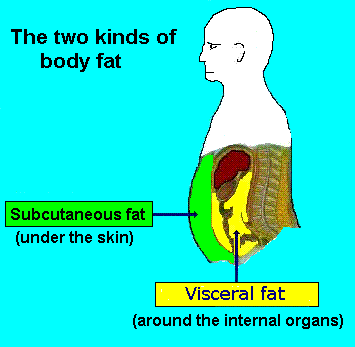 Picture credit: http://i578.photobucket.com
Picture credit: http://i578.photobucket.comAll fat is not created equal. Unsightly as it is, subcutaneous fat, the fat right under the skin, is not as dangerous to overall health as visceral fat, the fat deep in the belly surrounding vital organs.
According to a new study by researchers at Wake Forest Baptist Medical Center, the way to zero in and reduce visceral fat is simple: eat more soluble fiber from vegetables, fruit and beans, and engage in moderate activity.
The study found that for every 10-gram increase in soluble fiber eaten per day, visceral fat was reduced by 3.7 percent over five years. In addition, increased moderate activity resulted in a 7.4 percent decrease in the rate of visceral fat accumulation over the same time period.
“We know that a higher rate of visceral fat is associated with high blood pressure, diabetes and fatty liver disease,” said Kristen Hairston, M.D., assistant professor of internal medicine at Wake Forest Baptist and lead researcher on the study. “Our study found that making a few simple changes can have a big health impact.”
Ten grams of soluble fiber can be achieved by eating two small apples, one cup of green peas and one-half cup of pinto beans; moderate activity means exercising vigorously for 30 minutes, two to four times a week, Hairston added.
In the longitudinal study, published in the June 16 online issue of the journal Obesity, researchers examined whether lifestyle factors, such as diet and frequency of exercise, were associated with a five-year change in abdominal fat of African Americans and Hispanic Americans, populations at a disproportionally higher risk for developing high blood pressure and diabetes and accumulating visceral fat.
At the beginning of the study, which involved 1,114 people, the participants were given a physical exam, an extensive questionnaire on lifestyle issues, and a CT scan, the only accurate way to measure how much subcutaneous and visceral fat the participants had. Five years later, the exact same process was repeated.
Researchers found that increased soluble fiber intake was associated with a decreased rate of accumulated visceral fat, but not subcutaneous fat.
“There is mounting evidence that eating more soluble fiber and increasing exercise reduces visceral or belly fat, although we still don’t know how it works,” Hairston said. “Although the fiber-obesity relationship has been extensively studied, the relationship between fiber and specific fat deposits has not. Our study is valuable because it provides specific information on how dietary fiber, especially soluble fiber, may affect weight accumulation through abdominal fat deposits.”
Hairston’s next study, expected to be in clinical trials later this summer, will examine whether increasing soluble fiber with a widely available fiber supplement will produce similar results to those obtained in this study using soluble fiber from food.
The National Institutes of Health provides more information on soluble fiber.
SOURCE: Wake Forest Baptist Medical Center, news release, June 27, 2011
Related Posts in The Zestzfulness Library
Dec 14, 2010 - A study presented at the annual meeting of the Radiological Society of North America (RSNA)1 found that young premenopausal women with excessive amounts of visceral fat2are at increased risk for osteoporosis. ...
Significant Belly Fat Loss Seen With Orlistat
Feb 27, 2010 - In the three-month randomized placebo controlled Visceral Fat Imaging Study (2) trial 26 overweight and obese subjects took orlistat 60 mg 3 times a day and ate a hypocaloric (reduced by 500 kcal) low-fat diet. ...
Moderate Exercise keeps Dangerous Belly Fat away
Feb 26, 2010 - Moderate amounts of exercise, involving the equivalent of walking 30 to 45 minutes a day five days a week, even without a change in diet can reduce the inflammation in visceral fat, or belly fat, that has been linked with metabolic ...
Extremes of sleep duration increase BMI, SAT, and VAT
Apr 02, 2010 - Sleep Duration and Five-Year Abdominal Fat Accumulation in a Minority Cohort: The IRAS Family Study. SLEEP 2010;33(3):289-295. * Visceral fat is not the fat that lies just under your skin, that type is called subcutaneous fat. ...
Feb 05, 2010 - Visceral fat or belly fat is particularly dangerous because it produces inflammatory molecules that enter the bloodstream and increase the risk of heart disease and diabetes. Obese people have higher levels of circulating inflammatory ...
Brushing Teeth Less Than Twice a Day Nearly Triples Heart Disease Risk
Jun 02, 2010 - Periodontal Disease and Prostatitis. The Dangers of Belly Fat – the link between inflammation around the cells of visceral fat deposits, and the artery-hardening process of atherosclerosis. No, Not Hair Pulling.
Apple-shaped women at double risk of dementia
Mar 02, 2010 - Some of this fat resides just under the skin and is called subcutaneous fat. But much of it lies between and around the organs in the abdominal cavity—the liver, kidneys, pancreas and intestines—and is called visceral fat. ...
Zestzfulness: 80% OF STROKE RISK DUE TO 5 LIFESTYLE FACTORS
Jun 19, 2010 - Abdominal fat or visceral fat tissue is known to release various inflammatory cytokines (messenger proteins). During the course of ischaemic stroke, inflammatory mechanisms are among the important mediators of brain ...


No comments:
Post a Comment